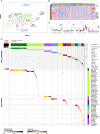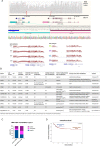UBTF::ATXN7L3 gene fusion defines novel B cell precursor ALL subtype with CDX2 expression and need for intensified treatment
- PMID: 35397658
- PMCID: PMC9162919
- DOI: 10.1038/s41375-022-01557-6
UBTF::ATXN7L3 gene fusion defines novel B cell precursor ALL subtype with CDX2 expression and need for intensified treatment
Conflict of interest statement
MBr received personal fees from Incyte (advisory board) and Roche Pharma AG, financial support for reference diagnostics from Affimed and Regeneron, grants and personal fees from Amgen (advisory board, speakers bureau, travel support), and personal fees from Janssen (speakers bureau), all outside the submitted work. The remaining authors declare no competing financial interests. None of the remaining authors has a relevant conflict of interest.
Figures


Similar articles
-
Concurrent CDX2 cis-deregulation and UBTF::ATXN7L3 fusion define a novel high-risk subtype of B-cell ALL.Blood. 2022 Jun 16;139(24):3505-3518. doi: 10.1182/blood.2021014723. Blood. 2022. PMID: 35316324 Free PMC article.
-
Enhancer retargeting of CDX2 and UBTF::ATXN7L3 define a subtype of high-risk B-progenitor acute lymphoblastic leukemia.Blood. 2022 Jun 16;139(24):3519-3531. doi: 10.1182/blood.2022015444. Blood. 2022. PMID: 35192684 Free PMC article.
-
A case of nasal low-grade non-intestinal-type adenocarcinoma with aberrant CDX2 expression and a novel SYN2-PPARG gene fusion in a 13-year-old girl.Virchows Arch. 2019 May;474(5):619-623. doi: 10.1007/s00428-019-02524-w. Epub 2019 Jan 21. Virchows Arch. 2019. PMID: 30666415
-
HOXB4 Gene Expression Is Regulated by CDX2 in Intestinal Epithelial Cells.PLoS One. 2016 Oct 18;11(10):e0164555. doi: 10.1371/journal.pone.0164555. eCollection 2016. PLoS One. 2016. PMID: 27755609 Free PMC article.
-
[Identity and intestinal pathologies: the Cdx2 homeotic gene].Ann Pathol. 2012 Nov;32(5 Suppl):S24-7. doi: 10.1016/j.annpat.2012.08.005. Epub 2012 Oct 12. Ann Pathol. 2012. PMID: 23127929 Review. French. No abstract available.
Cited by
-
The Gene Expression Classifier ALLCatchR Identifies B-cell Precursor ALL Subtypes and Underlying Developmental Trajectories Across Age.Hemasphere. 2023 Aug 25;7(9):e939. doi: 10.1097/HS9.0000000000000939. eCollection 2023 Sep. Hemasphere. 2023. PMID: 37645423 Free PMC article.
-
Molecular subgroups of T-cell acute lymphoblastic leukemia in adults treated according to pediatric-based GMALL protocols.Leukemia. 2024 Jun;38(6):1213-1222. doi: 10.1038/s41375-024-02264-0. Epub 2024 May 14. Leukemia. 2024. PMID: 38744920 Free PMC article.
-
Insights into IGH clonal evolution in BCP-ALL: frequency, mechanisms, associations, and diagnostic implications.Front Immunol. 2023 Apr 18;14:1125017. doi: 10.3389/fimmu.2023.1125017. eCollection 2023. Front Immunol. 2023. PMID: 37143651 Free PMC article.
-
UBTF tandem duplications are rare but recurrent alterations in adult AML and associated with younger age, myelodysplasia, and inferior outcome.Blood Cancer J. 2023 May 26;13(1):88. doi: 10.1038/s41408-023-00858-y. Blood Cancer J. 2023. PMID: 37236968 Free PMC article.
-
Oncogenic lesions and molecular subtypes in adults with B-cell acute lymphoblastic leukemia.Cancer Sci. 2023 Jan;114(1):8-15. doi: 10.1111/cas.15583. Epub 2022 Sep 27. Cancer Sci. 2023. PMID: 36106363 Free PMC article. Review.
References
-
- Yasuda T, Sanada M, Kawazu M, Kojima S, Tsuzuki S, Ueno H et al. Two novel high-risk adult B-cell acute lymphoblastic leukemia subtypes with high expression of CDX2 and IDH1/2 mutations. Blood. 2021: blood.2021011921. - PubMed
Publication types
MeSH terms
Substances
LinkOut - more resources
Full Text Sources

